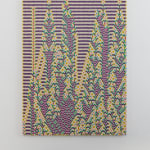-
Open a larger version of the following image in a popup:
 Exemplary image
Exemplary image
Troika
Reality is not Always Probable, 202222,695 colored dice, 10mm165 x 127 x 4 cm
65 x 50 x 1 5/8 inchesCopyright the artistsPhoto: Studio TroikaWeitere Abbildungen
„Reality is Not Always Probable“ (2022) ist ein Wandobjekt, dessen wellenförmiges Muster sich aus der Anordnung tausender bunter Würfel ergibt. Ausgehend von Troikas Interesse an den Zusammenhängen zwischen Zufall und...„Reality is Not Always Probable“ (2022) ist ein Wandobjekt, dessen wellenförmiges Muster sich aus der Anordnung tausender bunter Würfel ergibt. Ausgehend von Troikas Interesse an den Zusammenhängen zwischen Zufall und Kontrolle stellt die Arbeit die Materialisierung einer computerbasierten Simulation dar. Für die neuesten Werke der Serie entwickelte Troika einen komplexeren Algorithmus als zuvor, der von John Horton Conway’s „Spiel des Lebens“ inspiriert ist. Der Mathematiker entwickelte 1970 ein einfaches Regelwerk – ein Algorithmus – das auf ein einfaches Gitter von Spielsteinen angewendet wird und mit dem komplizierte Verfahren erklärt werden können. Sein Algorithmus wurde dann zur Modellierung des Bevölkerungswachstums, musikalischer Kompositionen, künstlicher Lebensformen und sogar der Evolution verwendet. Sein einfaches „Spiel“ hat Biolog:innen, Wissenschaftler:innen und Philosoph:innen geprägt. Troika greifen dies auf, um anhand des Algorithmus verschiedene Muster zu formen, wobei diese nicht voraussagbar sind, sondern sich in jedem neuen Vorgang anordnen können. Troika beginnt in diesem Werk mit einer zufälligen Reihe von farbigen und weißen Würfeln in der oberen Reihe. Jede weitere Würfelreihe und Farbwahl wird daraufhin durch die darüber liegende Reihe bestimmt. Anders als bei frühen Arbeiten der Werkserie, ist der Algorithmus nicht mehr binär und so definiert, dass die Farbe der Würfel berücksichtigt wird, aus dem dann die organischen, wachstumsähnlichen Muster hervorgehen.
Troika bezieht sich auf die historische Verwendung von Würfeln als Mittel zur Bestimmung von Schicksal, Zufall und Glück. Der Würfelwurf beruht auf den Wahrscheinlichkeitsgesetzen, zu denen der Prozess des Algorithmus konträr verläuft. Er ist autonom und kann unabhängig vom Alltagsleben existieren, während das reale Leben zunehmend durch computerbasierte Systeme beeinflusst wird. Die Arbeit verdeutlicht Troikas Untersuchungen, sichtbar zu machen, wie neue Technologien die physische Realität und deren individuelle Wahrnehmung durchdringen.
"Reality is Not Always Probable" (2022) is a wall object whose pattern results from the arrangement of thousands of colorful cubes. Based on Troika's interest in the connections between chance and control, the work represents the materialization of a computer-based simulation. For the latest works in the series, Troika developed a more complex algorithm than before, inspired by John Horton Conway's "Game of Life." In 1970, the mathematician developed a simple set of rules - an algorithm - applied to a simple grid of game pieces that could be used to explain complicated procedures. His algorithm was then used to model population growth, musical compositions, artificial life forms and even evolution. His simple "game" has influenced biologists, scientists and philosophers. Troika take this up to form different patterns using the algorithm, where these are not predictable, but can arrange themselves in each new process. In this work, Troika begins with a random row of colored and white cubes in the top row. Each subsequent row of cubes and color choice is then determined by the row above. Unlike early works in the series, the algorithm is no longer binary and defined to take into account the color of the cubes, from which the organic, growth-like patterns then emerge.
Troika refers to the historical use of dice as a means of determining fate, chance, and luck. The throw of the dice is based on the laws of probability, to which the process of the algorithm is contrary. It is autonomous and can exist independently of everyday life, while real life is increasingly influenced by computer-based systems. The work illustrates Troika's investigations to make visible how new technologies permeate physical reality and its individual perception.











